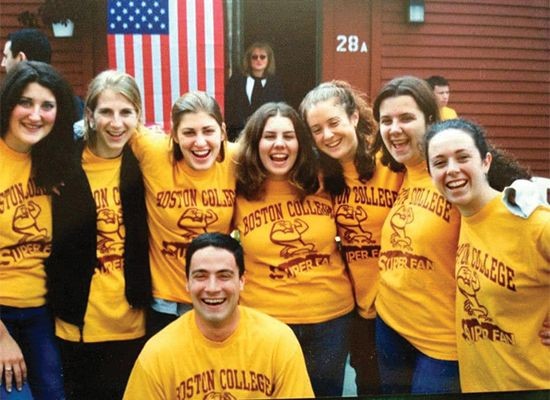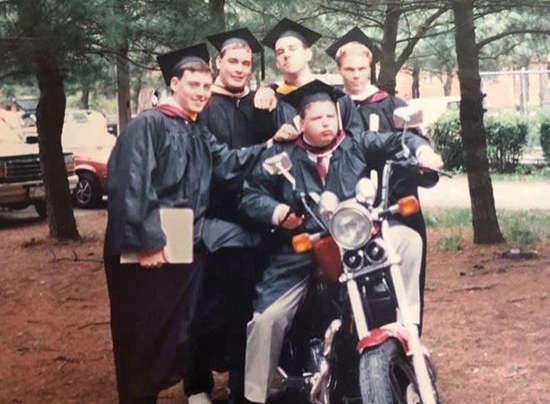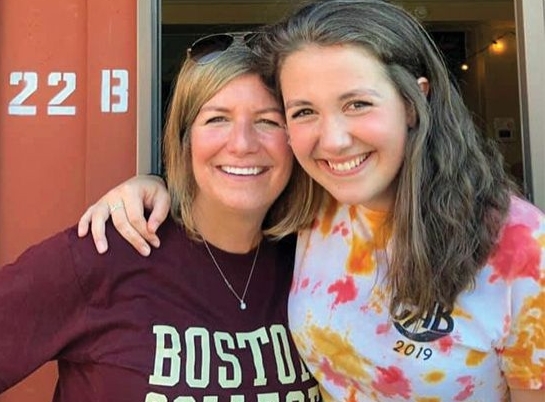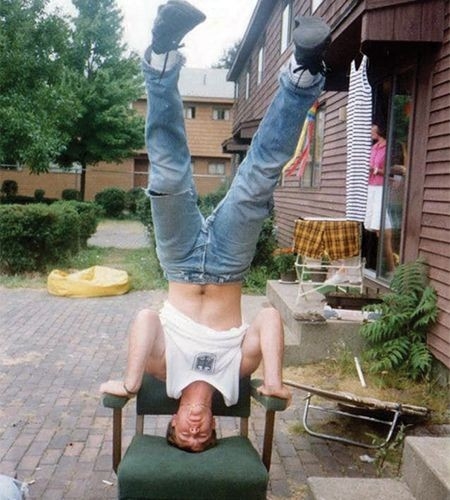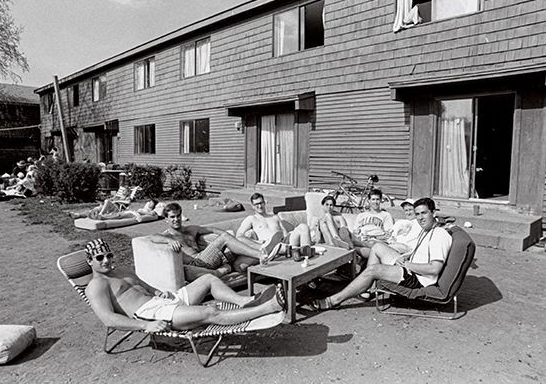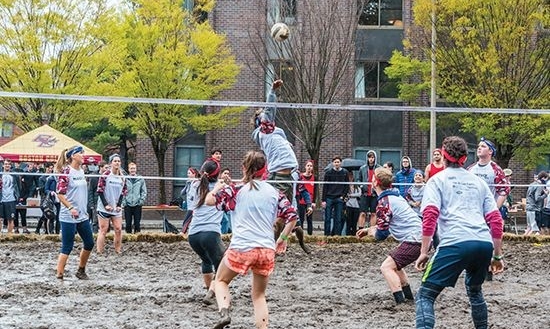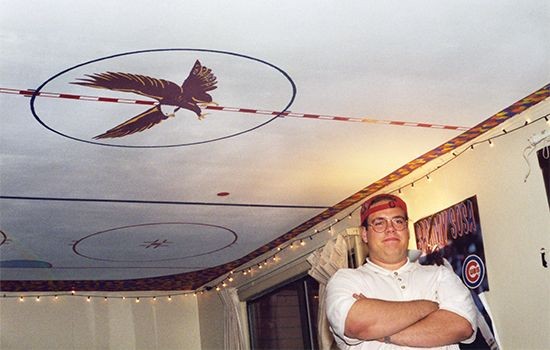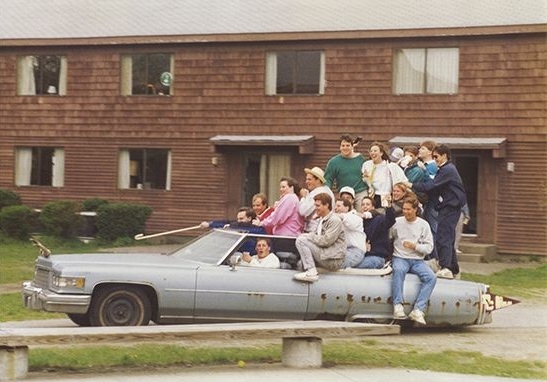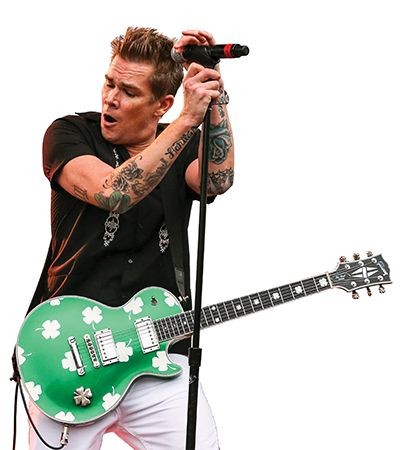(Photo: Caitlin Cunningham)
I’d never heard of the Mods until I arrived on the Boston College campus for orientation in the summer of 1994. “What’s up with these little houses?” I asked, as my classmates and I walked through lower campus. “That’s where the seniors live,” a fellow incoming freshman said. “That’s where you want to be.”
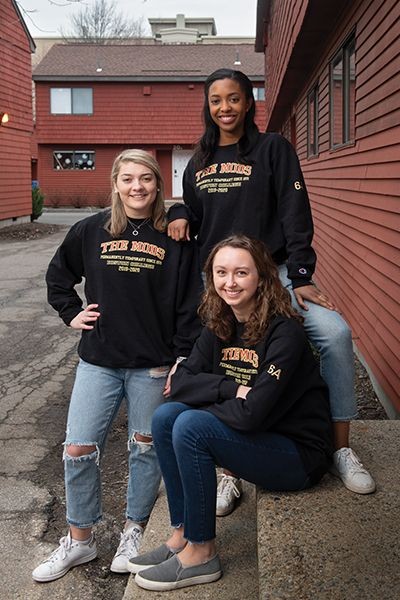
Each year, students vote on a slogan for the official Mod sweatshirts. Clockwise from left, current Mod 6A residents Sarah Marchese ’20, Kaelin Bush ’20, and Natalie Hoy ’20 show off this year’s version, which proclaims: “The Mods: Permanently Temporary Since 1971.” (When the duplexes opened in 1970, the Class of 1971 were the first seniors to live in them.) (Photo: Peter Julian)
The prefab, two-story Mods (short for modular housing) were installed in 1970, and they’ve developed a certain mystique, both because they are somewhat exclusive—there’s room for only 438 seniors to live there, about a fifth of the class—and an epicenter of campus culture. Being a Mod resident carries with it a certain cachet. Sure, you get in through sheer luck, but the perception has always been that people who live in the Mods are part of a special club. As one friend used to say—without a whiff of hyperbole—“Everything happens in the Mods.”
So, despite the fact that they were small and dingy, there wasn’t a single person I knew who didn’t want to call one of the ruddy-brown huts home. You could score a Mod only by selecting five potential roommates and then hoping your number was drawn in the annual housing lottery. As the drawing rolled around during my senior year, I remember classmates saying little prayers, hoping divine intervention would deliver them into the Mods. When fate inevitably denied a space to the majority of us, there was heartache.
I recall a post-lotto conversation with one of my disappointed roommates. He was a legacy who’d basically grown up on campus, attending football, basketball, and hockey games. For Bryan, applying to BC was preordained, a no-brainer. And the way he saw it, Mod living was practically a birthright. “I always envisioned that that’s where I’d live,” he said. “I was devastated.”
Just how beloved are the Mods? In his 2002 Commencement address, the former NATO ambassador Nicholas Burns ’78 mentioned exactly one BC building: the Mod where he had lived (36A). After his speech, Burns made only a couple of stops on campus. One of them was a visit to 36A.
When the Mods opened, they were intended as temporary housing. Half a century later, it is difficult to imagine the Heights without them.
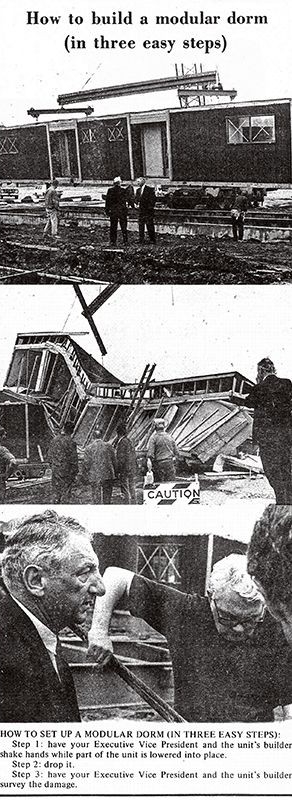
(Photos: Courtesy of The Heights)
What makes the Mods’ story doubly fascinating is their inauspicious beginning. In 1970, BC was facing a housing crisis. Earlier that year, the first women had matriculated, and the university was in the middle of a transformation from a predominantly commuter school to a residential one. There simply wasn’t enough housing on campus to accommodate the influx of new students. Plans to build a large dorm had fallen through, so administrators came up with a short-term solution: situate forty-three prefabricated modular duplexes on lower campus. Each duplex had two 1,100-square-foot units—A and B—with room for six seniors in each unit, plus patios and yards. They were supposed to be in place for only five years or so and then be razed to make way for new dorms.
When installation day came in early September 1970, Jim Lewis ’72, MA’75, and his roommates were there. They were set to live in the very first unit. “We watched the crane lift Mod 1A off the flatbed and hover it about 20 feet over the pad,” said Lewis, who lives in Southborough, Massachusetts. “And then the chain broke. The Mod fell and smashed and splintered. Toilets were smashed, the doors were smashed.” Lewis was horrified at first. “And then we just started laughing, thinking it was the funniest thing we’d ever seen,” he said. (The Heights memorialized the mishap with a strip of photos in the September 15, 1970, issue.)
The Mods—including a new 1A—were gradually trucked onto campus, and though some students were able to move in at the end of October, a plumbers’ strike, bad weather, and faulty pipe fittings delayed full occupancy until December. While they waited, Lewis and everybody else who was supposed to reside in the Mods were instead shuttled to nearby hotels. (Two intrepid students, Bill Cagney ’72 and Tom Gibbons ’72, even pitched a tent behind Shaw House, according to The Heights.) Despite the initial hiccups, the Mods proved a fast success. “They had living rooms, kitchens, separate bedrooms. They were appealing because they were little apartments,” said Professor James O’Toole ’72, the Clough Millennium Chair of History and the author of a forthcoming history of Boston College. “The primary alternative were two-person cells on upper campus.”
Even as new dorms with modern conveniences sprung up, seniors continued to opt for the cramped spaces with the paper-thin walls. “You could talk through them,” Lewis recalled. “You could have entire conversations with the people in the Mod next door.”





